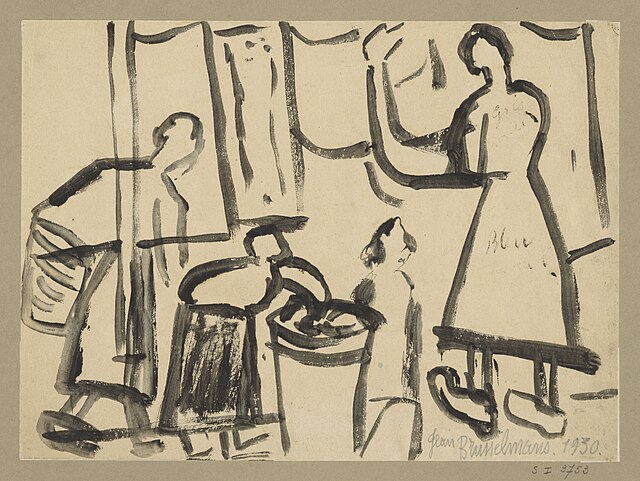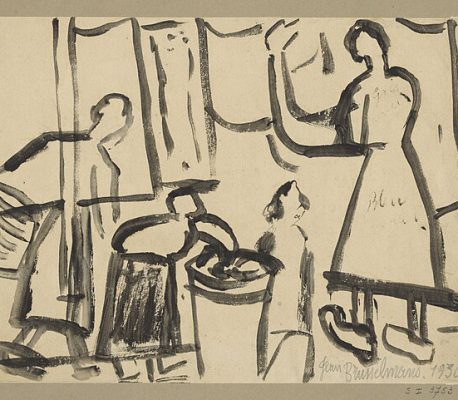When looking for people to interview, I wanted to interact with people who work within or with media and are related in some way to social studies. I tried contacting the author of a podcast that I’ve been listening to for the past years (and that I use to keep my French fresh), Les couilles sur la table, but given the holiday season, my outreach was unsuccessful. However, I started asking my friends if they knew someone open to sitting down for an interview with me. I explained to them that it was for my university assignment, to help make it more “casual”, and I got back some contacts of potential interviewees. Two of them were O. and C. (keeping their names anonymous as they requested me).
First Contact
I contacted both on WhatsApp using the same message:
Hi! My name is Anisa, nice to meet you! I got your contact through my friend, thank you for your interest! To give you more context, the purpose of my interview is to understand different perspectives of people who work with/within media environments and have touched upon social studies before. It will be a semi-structured interview with a rather broad topic, so I hope that through my questions we’ll be able to discover a subject that I imagine is interesting for both of us.
I’m doing this exercise for my Masters (I’m studying Communication Studies at Malmö University). The findings of this interview will be published online, on our university student blog, in a written format, but no worries, it is not necessary that your identity is revealed:) Let me know if this sounds good, I’m available for any further questions or clarifications!
Since the people that I contacted are of my age and I got their contact through friends, I decided to send an informal message on WhatsApp rather than a formal email. This was a conscious choice to help set the setting and put my potential participants at ease. Fortunately, both of them agreed to continue and accepted my invitation, and already expressed excitement and curiosity about my student blog project and my choice of topic. This gave me a confidence boost and gave me a bit of comfort to go into this interview. In the following messages, we set the time and place, with O. over Zoom call and C. in person, at her home, in Milan.
Interview with O.
O. is a master’s degree student and is currently based in London. Even though both of us are Romanian, the Zoom interview unfolded in English. This is an interesting finding that I now realize as I’m writing this blog. Even though we started the call in Romanian, to make sure my interviewer was ready and comfortable to start, as soon as we initiated the interview, we both just naturally switched to English. This is a curious find that reveals that even though we are both native Romanian speakers since we both always studied in English, we associate the “formal” / “academic” setting with English and keep Romanian for just informal warm-up.
Moreover, I felt that English allowed more expression in using technical terms that we just naturally only learned in English (given both of us studied Media Studies in English-based courses). However, I believe that if we continued the interview in Romanian, perhaps we would have indeed felt limited in expressing “technical words” but we’d reveal more depth to our experiences since we touched a lot upon the recent Romanian elections and the impact George Calinescu had on our society.
Rapport
I felt a bit anxious before the interview started since I never held a Zoom interview before and it was my first time meeting her. However, we both quickly grew comfortable with each other. The semi-structured format of the interview helped to give me a sense of order, following the questions I had prepared, but still allowing both of us to expand and go more deeply into some subjects.
Moreover, it allowed us both to feel more at ease and not constrained to strict questions and formats. I found myself naturally asking more follow-up questions to deepen my understanding of her answers, while always being careful not to limit her to “Yes or No” questions or word my questions in such a way that further limits her answers. It was an exciting mental exercise and I felt that it helped me position myself in the seat of the “listener”. This “narrative linkage” allowed my participant to deepen her stories organically, and create meaning in a collaborative manner (Holstein & Gubrium,1995). We had an informal rapport, that I believe was given by the structure of the interview, the topic chosen which is familiar to both of us, and the Romanian background that we both share.
LIMITATIONS
While conducting a Zoom call was definitely easier to plan, the lack of personal touch left me feeling slightly alienated. Since both of us quickly grew informal and excited about the topic discussed, I felt the limitation of expressing how I felt with limited body language. Moreover, I encountered difficulties in reading her bodily expressions, not only because of visual limitations but also because of poor internet connection, which disrupted the flow of our conversation and made it even more awkward at times.
I assumed that since I let her choose the time and day of the interview, she would feel at ease participating, but that was not entirely the case. Unfortunately, having recently moved into a shared flat in London, she did not feel entirely at ease with her flatmates and I felt her anxiety limited her in fully expressing her answers.
Interview with C.
C. is an Italian PHD graduate, also London-based. However, luckily for me, she was home in Milan for the holiday season so we were able to meet and conduct the interview in person. Even though we both know and speak Italian, the interview unfolded in English.
Rapport
When deciding on the time and place of the interview, I let her know that I’m available to come and meet her wherever she feels most comfortable. Therefore, she invited me to her home. Unfortunately for me, her house was a bit far from mine, and I had to take a train to meet her just a little outside of Milan. I would have preferred meeting in a public, shared space but I wanted to offer the possibility of feeling at ease. Nevertheless, all my anxiety quickly faded away as soon as I reached her house. She welcomed me with some biscuits and coffee and had already prepared our “interview setting”, at the kitchen table.
Differently than with O. I could quickly tell through her body language that she was excited and curious to get started, and did not feel stressed or anxious at all. She told me that in her academic career, she had to interview some people as well, and was excited to be the one that is interviewed. Given her strong academic background, I felt she more superior to me and afraid she’d judge my interview skills or questions. However, she was really supportive and thankful for choosing her for my exercise which helped me relax as well.
Limitations
Compared to the online interview, I enjoyed much more the setting of the in-person one; partly also because C. was so open and welcoming. Nevertheless, the limitations I faced were the time and cost implications that I had to bear to travel to meet her at her home. Fortunately, we scheduled the meeting during the holiday season, which allowed me to have more time flexibility, however, I can easily see how challenging it would have been for me to meet her in normal circumstances. Moreover, it felt less disruptive to record the Zoom meeting, since you’re already meeting in a technical context and you simply just press the “Record” button, while for the in-person interview, having a microphone recording has more of a physical presence that is felt during the interview.
PERSONAL Learnings
Throughout the blog, I’ve written the impressions I’ve had after conducting both interviews and how differently can time, space, and format of the interview influence its findings. One thing is for sure, this was a challenging exercise from multiple aspects, socially – having to reach out and meet with someone I’ve never met before and even travel to their home, academically – to think and prepare for research questions, and mentally – to keep the dialogue alive through follow-up questions while not influencing the course of meaning the interviewee intended (Trier-Bieniek, 2012). This exercise has been an enriching experience, making me step out of my comfort zone and strengthen my adaptability, communication, and active listening skills while witnessing how theoretical knowledge translates into real-world contexts.
Feature Image: People, drawing by Jean Brusselmans, 1930, Prints Department of the Royal Library of Belgium, S.I 3753.jpg via Wikimedia Commons.


